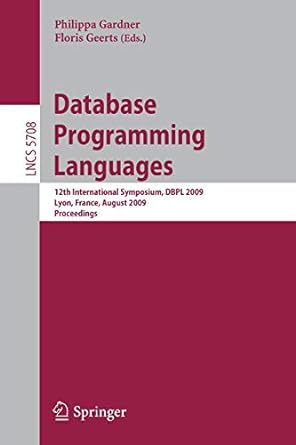Question
1) Show that 6n 2 + 20n is big-Oh of n 3 , but not big-Omega of n 3 . You can use either the
1) Show that 6n2 + 20n is big-Oh of n3, but not big-Omega of n3. You can use either the definition of big-Omega (formal) or the limit approach
2) Show that n3 is big-Omega of n2. You can use either the definition of big-Omega (formal) or the limit approach.
3) Consider the following algorithm:
int j = 1;
int k = 1;
for (i = 1; i <= 10; i++)
j = j * 100;
for (i = 1; i <= 20; i++)
k = k * 2;
What is the running time, T(n)? Give both the exact function T(n), and then give a big- Theta estimate of T(n). Show your work. For example, if T(n) is exactly n2 + 3n, then T(n) is big-Theta of n2.
4) Consider the following algorithm:
int k = 0;
for (i = 2; i <= n; i++)
for (j = 0; j <= n; j++)
k = i + j;
What is the running time, T(n)? Give both the exact function T(n), and then give a big- Theta estimate of T(n).
5) If the worst case time of algorithm A is big-oh of that of B, then B is not faster than A for large problems. (True or False) Explain! Then consider if A is strictly big-oh, how about then?
6) n4 is big-oh of n6. (True or False)
7) Since 2(2n + 5) >= 3n for n >= 0, and 3n >= 2n + 5 for n >= 5, 2n + 5 is big-oh of 3n. (True or False)
8) If f(n) is big-theta of g(n), then the value of f may be infinitely away from that of g. (True or False)
Step by Step Solution
There are 3 Steps involved in it
Step: 1

Get Instant Access to Expert-Tailored Solutions
See step-by-step solutions with expert insights and AI powered tools for academic success
Step: 2

Step: 3

Ace Your Homework with AI
Get the answers you need in no time with our AI-driven, step-by-step assistance
Get Started


